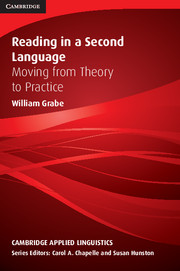Book contents
- Frontmatter
- Contents
- Series editors' preface
- Preface
- I FOUNDATIONS OF READING
- II PATTERNS OF VARIATION IN READING
- III DEVELOPING READING COMPREHENSION ABILITIES
- IV EXPANDING READING COMPREHENSION SKILLS
- Chapter 14 Reading fluency, reading rate, and comprehension
- Chapter 15 Extensive reading
- Chapter 16 The reading curriculum and instruction
- Chapter 17 Reading assessment
- Chapter 18 Further topics and issues in reading
- References
- Author Index
- Subject Index
Chapter 18 - Further topics and issues in reading
from IV - EXPANDING READING COMPREHENSION SKILLS
Published online by Cambridge University Press: 05 August 2012
- Frontmatter
- Contents
- Series editors' preface
- Preface
- I FOUNDATIONS OF READING
- II PATTERNS OF VARIATION IN READING
- III DEVELOPING READING COMPREHENSION ABILITIES
- IV EXPANDING READING COMPREHENSION SKILLS
- Chapter 14 Reading fluency, reading rate, and comprehension
- Chapter 15 Extensive reading
- Chapter 16 The reading curriculum and instruction
- Chapter 17 Reading assessment
- Chapter 18 Further topics and issues in reading
- References
- Author Index
- Subject Index
Summary
Reading is a neuronally and intellectually circuitous act, enriched as much by the unpredictable indirections of a reader's inferences and thoughts as by the direct message to the eye from the text. This unique aspect of reading has begun to trouble me as I consider the Google universe of my children. Will the constructive component at the heart of reading begin to change and potentially atrophy as we shift to computer-presented text, in which massive amounts of information appear instantaneously?
(Wolf, 2007: 16)In this last chapter, I raise a number of the topics that were not explored intensively in this book. A first set of topics are important for discussions of L2 reading but do not fit easily within the scheme of the current book. These topics include reading and writing relationships, teacher training for more effective reading instruction, early L1 and L2 reading development, and L2 basic adult literacy instruction. A second set of topics involve areas of specialization that extend beyond the area of L2 reading and that require specific types of expertise to develop into full chapters in a book on L2 reading. These topics include reading and neurological research, reading and technology, reading and TV viewing, and reading disabilities. In a very different type of book, all of these topics might have had their own chapters.
In the third section, I address the role of research in supporting reading instruction and the impact of educational and governmental policies on reading instruction. It is obvious that research is needed to examine many instructional practices, their effectiveness under different circumstances and with different groups of students, and their integration within curricular frameworks.
- Type
- Chapter
- Information
- Reading in a Second LanguageMoving from Theory to Practice, pp. 376 - 390Publisher: Cambridge University PressPrint publication year: 2008



